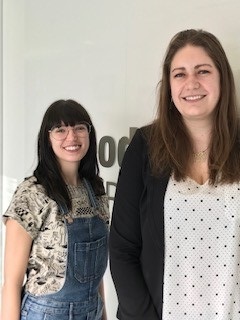Each morning, delivery trucks pull up to the loading dock at the Bode Technology headquarters in Lorton, Va. They carry hundreds of cardboard boxes from around the country—10 from Houston, 20 from Detroit, sometimes as many as a thousand from one city alone. Inside each box are piles of envelopes marked “Evidence.”
The boxes are sexual assault kits—commonly known as rape kits. The envelopes contain swabs of bodily fluids, hair clippings and even underwear and clothing. They all represent evidence collected by nearly 200 crime laboratories and law enforcement agencies from victims of alleged assaults. Some are recent, some date back decades.
And none of them have ever been tested.

DNA analysts (from left) Jaclyn Benjamin, MFS ’14, and Lauren Macdonald, MFS ’15
“There is a crisis of untested sexual assault kits,” said Mike Cariola, MFS ’99, the CEO, president and owner of Bode, a forensic sciences lab that employs more than 20 graduates of Columbian College’s Forensic Sciences Program among its 150 DNA analysts, investigators and technicians. With as many as 400,000 sexual assault kits sitting in evidence lockers and police labs across the country, those alumni are at the forefront of clearing the backlog using cutting-edge technology to identify an unknown assailant, link crimes or stop serial offenders. They can affirm a survivor’s account of an attack and exonerate the innocent.
“My work might find some resolution for the victim or it might free someone who isn’t a match,” said DNA Analyst Lauren Macdonald, MFS ’15. “At end of the day, I’m just trying to help people.”
Making a Forensic Impact
Every 98 seconds, someone is sexually assaulted in the United States. In a sense, the victims’ bodies become part of the crime scene. Many submit to photographs, swabs and invasive examinations. Still, most assailants aren’t caught—let alone convicted. The United States has only a 20 percent arrest rate for rape crimes and only a 40 percent clearance rate, notes Department of Justice figures. Sexual assault kits that have not been processed certainly contribute to those dismal figures, Cariola said, but the reasons for the backlog are varied, from a lack of law enforcement resources and manpower to ignorance about the forensic usefulness of the kits. If, for example, a victim already identified her attacker, police might not examine the kit, even though it could contain DNA linking the assailant to other unsolved crimes.
There’s no federal law requiring the examination of rape kits. But a 2017 report by the National Institute of Justice recommended all kits connected to a reported crime be submitted to a lab for DNA analysis. And since 2016, victims advocates have helped pass 34 testing laws and four resolutions in 26 states.
Some of the kits that arrive at the Bode loading dock are too degraded to offer useable evidence. DNA Analyst Jaclyn Benjamin, MFS ’14, said she has worked on moldy kits from damp warehouses and water-damaged samples from Hurricane Katrina sites. “DNA breaks down over time, especially if it’s kept in damp and hot conditions,” she said. “Sometimes we try our best, but we just can’t get good information from them.”
But sometimes the results can be startling. In 2000, Cariola worked with New York City officials to clear a backlog of 6,000 rape kits. Since then, New York’s sexual assaults arrest rates jumped from 40 percent to 70 percent. In 2009, more than 11,000 rape kits were found in an abandoned Detroit storage facility. The tested kits have identified 821 rapists who had committed crimes in 40 states and Washington, D.C. And the testing effort is still ongoing.
“Forensic scientists have an immediate impact on society,” said Associate Professor of Forensic Sciences Daniele Podini. “As educators in this field we are well aware of the importance of the job our graduates do, and we do our best to prepare them with both technical and theoretical knowledge.”
At Bode, teams of DNA analysts examine hundreds of boxes a month. The laborious process involves cutting samples from individual swabs or clothing, extracting the DNA through chemical and automated processes and then determining whether the samples are distinctive enough to construct a DNA profile. “Over 99 percent of our DNA is the same from person-to-person,” Cariola said. “We are looking for those rare markers that individualize each person.”
A high-tech sample-extracting robot has helped yield faster DNA profiles. Rather than technicians preparing each sample by hand, Bode’s robots can process 80 at a time. Keeping abreast of the field’s fast-moving technology is critical for forensic analysts, a fact that Podini stresses in his classes. “The technology changes so rapidly that students must always be learners,” he said. “I can teach them the technology they will use on their first case. But I have no idea what technology they will use on their last case before they retire. It probably hasn’t been invented yet.”
The cutting–edge technology in Bode’s labs have helped clear backlogs of untested sexual assault kits.
The analysts often know only the bare minimum facts surrounding each sample— a brief case folder on the assault; the ages, gender and medical condition of the victims; perhaps a physical description of a suspect. Limiting their case-knowledge prevents them from introducing their own personal biases. “The less we know, the better,” Benjamin says. “We are reporting hundreds of cases a month. We have to push the personal side to the back of our minds and concentrate on what’s in front of us.” Whether she’s unraveling microscopic strands of DNA or testifying in court, Benjamin says her forensic science studies gave a her a firm footing in the most important aspect of her work: the science. “Some days I’m trying to explain DNA to a jury or a detective and some days I’m looking at evidence on a molecular level,” she said. “Either way, having a good background in the science that goes into DNA testing has always been the bottom line in getting the job done.”



